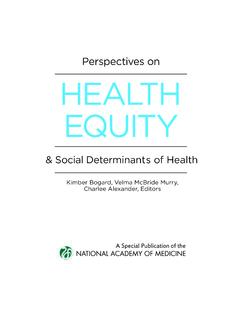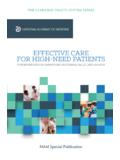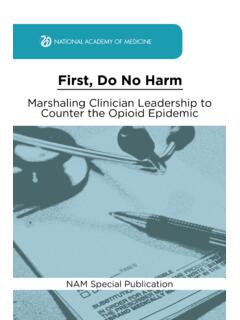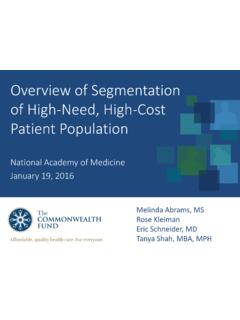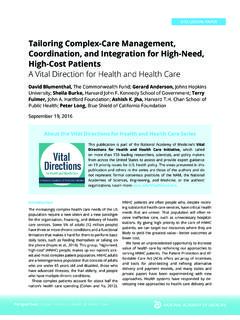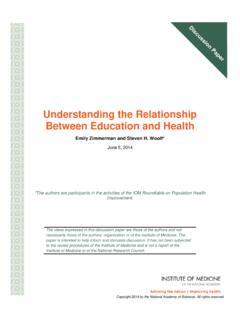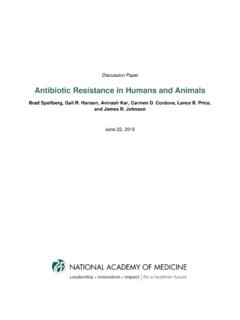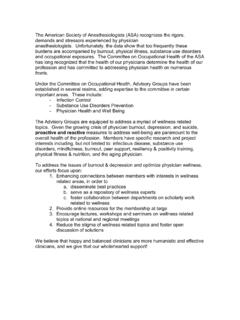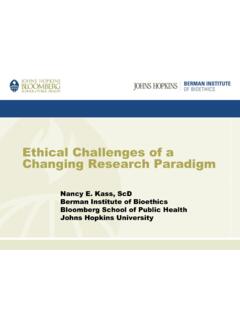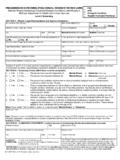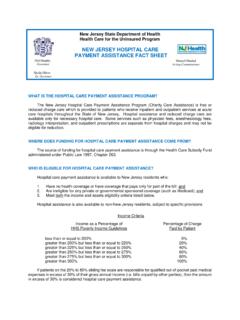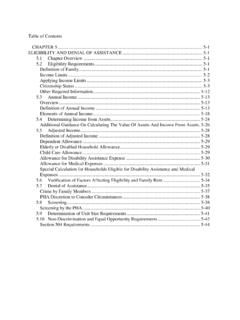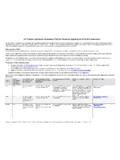Transcription of Standardized Screening for Health-Related Social Needs in ...
1 DISCUSSION PAPER. Standardized Screening for Health-Related Social Needs in Clinical Settings The Accountable Health Communities Screening Tool Alexander Billioux, MD, DPhil, Centers for Medicare & Medicaid Services;. Katherine Verlander, MPH, Centers for Medicare & Medicaid Services;. Susan Anthony, DrPH, Centers for Medicare & Medicaid Services;. Dawn Alley, PhD, Centers for Medicare & Medicaid Services May 30, 2017. The impacts of unmet Health-Related Social Needs , such as homelessness, inconsistent access to food, and exposure to violence on health and health care utilization, are well-established.
2 Growing evidence indicates that addressing these and other Needs can help reverse their damaging health effects, but Screening for Social Needs is not yet standard clinical practice. In many communities, the absence of established pathways and infrastructure and perceptions of inadequate time to make community referrals are barriers that seem to often keep clinicians and their staff from broaching the topic. The Centers for Medicare & Medicaid Services (CMS). Accountable Health Communities Model, tested by the Center for Medicare and Medicaid Innovation, addresses this critical gap between clinical care and community services in the current health care delivery system by testing whether systematically identifying and addressing the Health-Related Social Needs of Medicare and Medicaid beneficiaries impacts their total health care costs and improves health.
3 With input from a panel of national experts and after ed Social Needs (HRSNs), such as housing instability, review of existing Screening instruments, CMS devel- food insecurity, and exposure to interpersonal vio- oped a 10-item Screening tool to identify patient Needs lence, drive health care utilization and impact health in 5 different domains that can be addressed through outcomes [1, 2, 3]. Clinicians routinely employ stan- community services (housing instability, food insecu- dardized questions and validated assessment tools rity, transportation difficulties, utility assistance Needs , to screen for clinical and behavioral drivers of poor and interpersonal safety).
4 Clinicians and their staff can health, such as alcohol dependency, decompensated use this short tool across a spectrum of ages, back- heart failure, and depression, but Screening for HRSNs grounds, and settings, and it is streamlined enough to is not yet standard clinical practice [4, 5, 6]. Standard- be incorporated into busy clinical workflows. Just like ized application of Screening tools as a part of clinical with clinical assessment tools, results from this screen- routines allows provider teams to quickly and consis- ing tool can be used to inform a patient's treatment tently identify possible health Needs for further inves- plan as well as make referrals to community services.
5 Tigation and intervention. A variety of assessment tools have been developed to help health providers identify Introduction the presence of deleterious Social circumstances, and Evidence demonstrates that non-medical health-relat- a few recent studies have demonstrated the efficacy Perspectives | Expert Voices in Health & Health Care DISCUSSION PAPER. of Screening tools combining several HRSN domains in Screening for HRSNs in clinical settings across the identifying various HRSNs of patients and their caregiv- health care system.
6 Ers [7, 8, 9]. However, inadequate training, perceptions of inadequate time to investigate Social Needs , and, Tool Development: Design Principles and importantly, the absence of established pathways and Expert Consultation infrastructure to address identified unmet Needs are Out of the many non-medical Needs that impact health, barriers that often keep clinicians and their staff from CMS selected five core HRSN domains based on the implementing HRSN Screening at their clinical delivery following criteria : 1) high-quality evidence exists link- sites [10, 11, 12].
7 The Centers for Medicare & Medicaid ing the HRSN to poor health or increased health care Services (CMS) Accountable Health Communities (AHC) utilization and cost; 2) the need can be met by commu- Model will test whether addressing these delivery sys- nity service providers; and 3) the need is not systemi- tem barriers through universal HRSN Screening and cally addressed by health care providers. In developing enhanced clinical-community linkages can improve the AHC HRSN Screening tool for the five core domains, health outcomes and impact costs [13].
8 CMS followed three guiding principles. CMS developed the AHC Model to address a criti- First, the tool needed to consistently identify the cal gap between clinical care and community services broadest set of HRSNs that could be addressed by in the current health care delivery system by testing community service providers. Ideally, the Screening whether systematically identifying and addressing the tool would identify any unmet need within an inclusive HRSNs of Medicare and Medicaid beneficiaries im- focal area likely to have a negative impact on health, pacts total health care costs and utilization, increas- rather than specifying a particular subset of Needs .
9 The es the quality of care, and improves health. Through tool would allow clinical delivery sites to identify broad the model, CMS will support clinical and community Needs and engage navigators and community service partnerships coordinated by a backbone organi- providers, who are better suited to identify more spe- zation among clinical delivery sites, community ser- cific Needs and address the individualized issues that vice providers, and state Medicaid agencies. Clinical underlie unmet need. For example, the AHC HRSN.
10 Delivery sites hospitals, clinics, doctors' offices, and Screening tool would identify that an individual is at other clinical settings will serve as the crucial entry risk for food insecurity broadly, and the care naviga- point for the model by serving as the place of screen- tor or community service provider would identify the ing for all Medicare and Medicaid beneficiaries for un- individual's specific drivers of food insecurity, such as met Needs across five core HRSN domains: housing difficulty obtaining food near the end of pay periods or instability ( , homelessness, poor housing quality), daily need for food assistance.

